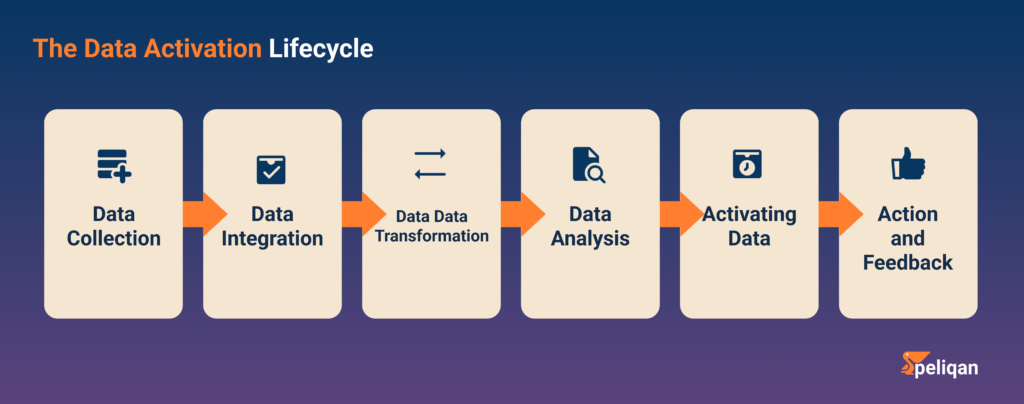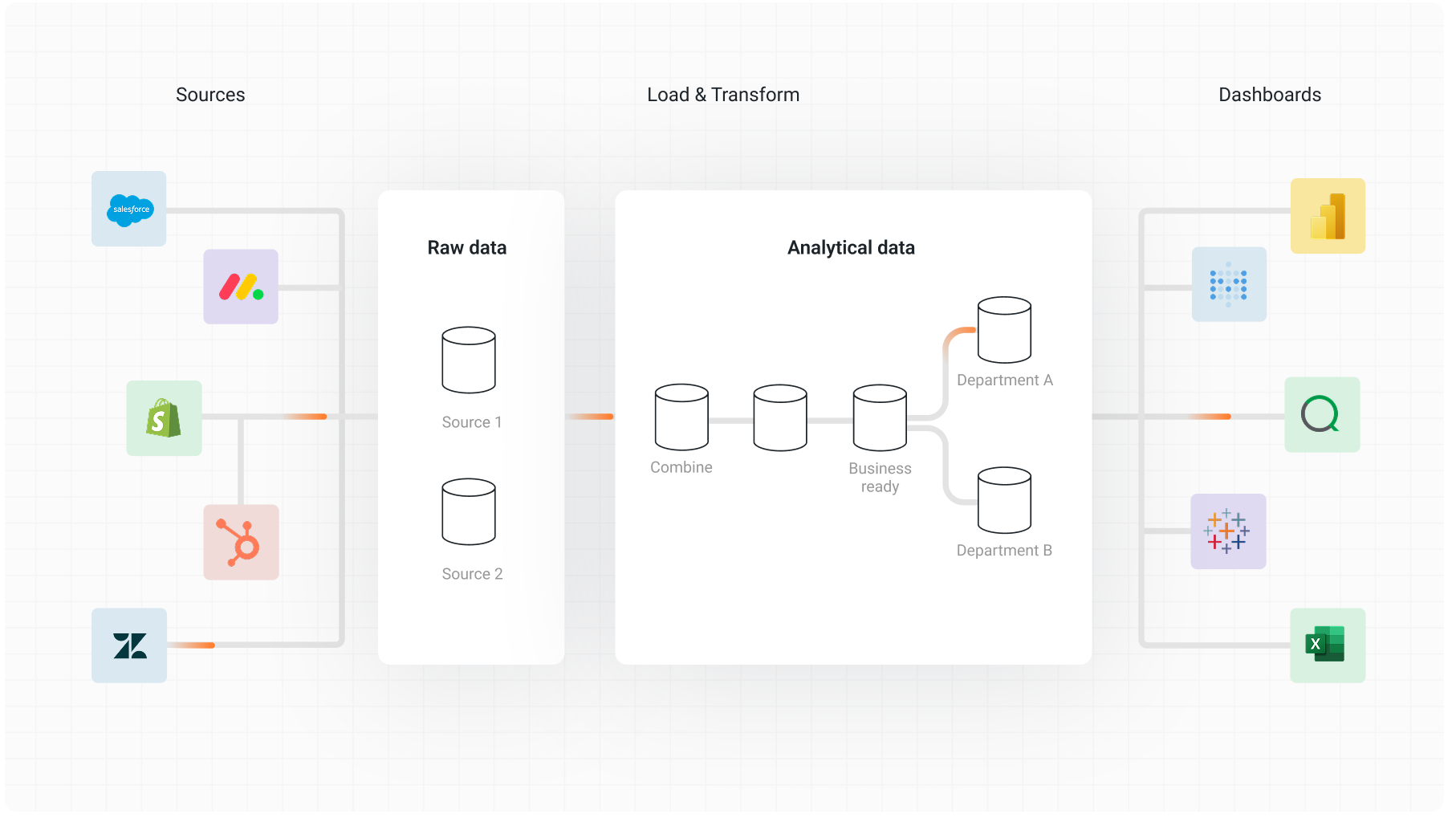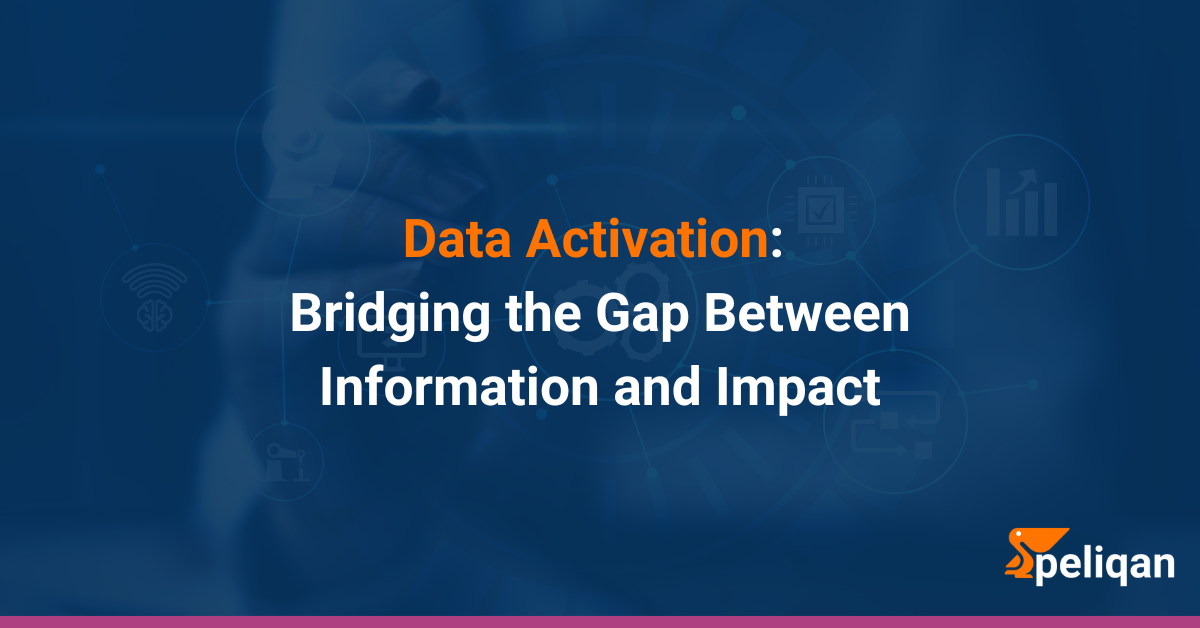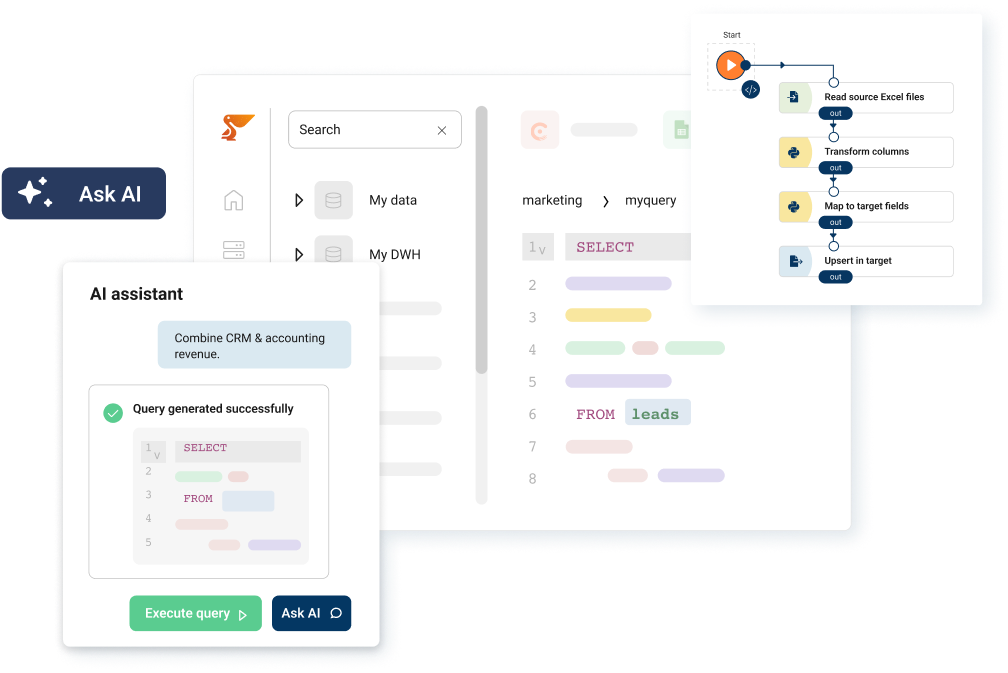In today’s data-driven business landscape, companies are collecting vast amounts of information about their customers, operations, and market trends. However, simply having data isn’t enough. To truly leverage its potential, organizations need to implement data activation strategies. This comprehensive guide will explore what data activation is, why it’s crucial for modern businesses, and how you can implement it effectively to drive growth and innovation. Before that…
Picture this: Your company has been diligently collecting data for years. Customer interactions, sales figures, market trends – you name it, you’ve got it.
But here’s the million-dollar question: Are you truly leveraging this goldmine of information?
Most businesses aren’t. They’re data-rich but insight-poor. This is where data activation comes in, ready to turn the tables and revolutionize your business operations.
What is Data Activation?
Data activation is the process of transforming raw data stored in various sources, such as data warehouses and lakes, into actionable insights that can be used by different teams across an organization. It involves making data accessible, understandable, and usable for business users, enabling them to make data-driven decisions and implement targeted strategies.
As defined by Peliqan, “Self-service data activation is a strategy that empowers organizations and business teams to work with data, beyond the classical BI reporting or a dependency on data engineering teams.” This definition highlights the importance of making data activation accessible to non-technical users across the organization.
Why is Data Activation Important?
The significance of data activation cannot be overstated, as it serves as the bridge between raw data and actionable insights, enabling businesses to harness their data for strategic advantage. By effectively activating data, organizations can drive informed decision-making, enhance operational efficiency, and ultimately foster innovation within their respective markets.
Unlocking Data Value
Data activation not only unlocks the potential of your organization’s data but also creates a data-driven culture. It encourages employees at all levels to engage with data, fostering a mindset of continuous improvement and data-backed decision-making. You can further encourage this culture by recognizing and rewarding employees’ contributions through an employee rewards software, which helps maintain motivation and engagement while promoting consistent use of data across teams.
Improving Decision-Making
Beyond improving operational efficiency and strategic planning, data activation enables predictive analytics. This allows businesses to anticipate market trends, customer behaviors, and potential risks, leading to proactive rather than reactive decision-making.
Enhancing Customer Experiences
In addition to personalization, data activation enables real-time customer interaction. It allows businesses to respond instantly to customer needs, preferences, and behaviors, creating seamless and highly satisfying customer journeys across all touchpoints.
Driving Innovation
Activated data can also lead to the creation of entirely new business models. By identifying patterns and opportunities in the data, companies can develop innovative products, services, or revenue streams that were previously unimaginable.
The journey towards effective data activation, however, requires a systematic approach that encompasses various tools, strategies, and best practices to ensure that data is not only collected but also transformed into a valuable asset for the organization.
The Data Activation Lifecycle
To fully understand data activation, it’s essential to consider it as part of a larger process known as the data activation lifecycle. This cycle consists of several key stages:

Data Collection
This stage involves not just gathering data, but also establishing protocols for data quality at the source. It includes setting up data validation rules, implementing data governance policies, and ensuring compliance with data protection regulations from the point of collection.
Data Integration
Beyond consolidation, this stage involves data mapping and metadata management. It’s crucial to maintain data lineage and create a comprehensive data catalog to track the origins, transformations, and usage of each data element throughout its lifecycle.
Data Transformation
This step also includes data enrichment, where external data sources are incorporated to add context and value to existing data. Advanced techniques like machine learning can be applied here to detect anomalies, fill in missing values, or generate derived features.
Data Analysis
In addition to extracting insights, this stage involves the creation of data visualizations and dashboards. It also includes the development and deployment of machine learning models that can automate complex analytical tasks and generate predictive insights.
Activating Data
This stage involves setting up automated triggers and alerts based on specific data conditions. It includes creating self-service analytics platforms that empower business users to interact with data directly and generate their own insights.
Action and Feedback
This final stage includes establishing key performance indicators (KPIs) to measure the impact of data-driven actions. It also involves creating feedback loops that continuously refine data models and activation strategies based on real-world outcomes.
This cyclical process ensures that data activation is an ongoing effort, constantly refined and improved based on outcomes and new data inputs.
Understanding the intricacies of the data activation lifecycle is crucial for organizations seeking to leverage their data effectively, as it delineates the necessary steps that must be undertaken to transition from raw data collection to actionable insights that can drive strategic initiatives.
Key Components of Data Activation
To successfully navigate the data activation lifecycle, organizations must consider several key components that contribute to effective data management and utilization. Each of these components plays a vital role in ensuring that data not only flows seamlessly through the lifecycle but also yields valuable insights that can drive the business forward.
| Data Activation Components | Description | Importance |
|---|---|---|
| Data Centralization | Consolidating data from various sources into a single source of truth, often using a cloud data warehouse | Provides a unified view of all data for consistent analysis |
| Data Quality and Governance | Implementing practices to ensure data accuracy, consistency, and compliance | Maintains the integrity and reliability of activated data |
| Data Modeling | Creating meaningful representations of business logic and customer attributes | Transforms raw data into valuable insights |
| Integration with Business Tools | Connecting centralized data to CRM systems, marketing platforms, and BI tools | Enables practical application of insights across different departments |
| Real-time Data Processing | Implementing systems for immediate data processing and activation | Allows for timely decision-making and instant action on fresh insights |
These key data activation components are not isolated; they interact dynamically within the data activation lifecycle, ensuring that data flows efficiently from collection to actionable insights.
By establishing a robust architecture that incorporates data centralization, quality governance, effective modeling, integration with business tools, and real-time processing, organizations can create a holistic ecosystem that amplifies the value of their data and drives competitive advantage.
Data Activation Use Cases
Building on the foundational elements of data activation, it is imperative to explore specific use cases that illustrate the transformative potential of effectively activated data across various industries and business functions. These examples not only highlight the versatility of data activation strategies but also demonstrate their capacity to drive measurable outcomes and enhance operational efficiency.
Marketing and Advertising
- Targeted Campaigns: Utilizing data activation enables marketers to segment audiences based on demographics, behaviours, and purchase history, leading to highly targeted and personalized marketing campaigns that significantly improve engagement and conversion rates.
- Real-time Analytics: Implementing real-time data processing allows marketing teams to monitor campaign performance instantly, facilitating the agile adjustment of strategies and budget allocation based on live feedback and emerging trends.
- Customer Journey Optimization: Activated data can uncover insights into the customer journey, helping businesses identify bottlenecks and optimize touchpoints, ultimately enhancing the overall customer experience and satisfaction.
- Predictive Analytics for Trends: By leveraging historical data and machine learning models, marketers can forecast market trends, identify potential opportunities, and anticipate customer needs, ensuring proactive rather than reactive marketing efforts.
Sales and Customer Success
- Enhanced Lead Scoring: By integrating activated data with CRM systems, sales teams can prioritize leads based on predictive scoring models that assess the likelihood of conversion, resulting in more focused and efficient sales efforts.
- 360-Degree Customer Views: Data activation provides sales professionals with comprehensive insights into customer interactions, preferences, and service history, enabling tailored selling approaches that resonate with individual client needs.
- Churn Prediction Models: Utilizing machine learning algorithms, organizations can identify customers exhibiting signs of potential churn, allowing proactive engagement strategies to retain at-risk clients and enhance customer loyalty.
- Performance Metrics Optimization: Real-time access to sales performance data enables teams to track key metrics and adjust tactics on-the-fly, fostering a culture of accountability and continuous improvement within the sales process.
Product Development
- Data-Driven Feature Prioritization: Leveraging activated data allows product management teams to identify which features are most valued by users, driving prioritization efforts that align product development with customer demands and market trends.
- User Feedback Integration: By activating data from user interactions and feedback mechanisms, product teams can iteratively refine existing features and identify areas for innovation based on real user needs and preferences.
- Performance Analytics for User Experience: Activation of real-time usage data equips teams with insights into how customers interact with products, facilitating adjustments that enhance usability, performance, and overall customer satisfaction.
- Market Fit Analysis: By analyzing activated data regarding competitive benchmarks and user demographics, product teams can evaluate product-market fit and make informed decisions on feature enhancements, pricing strategies, and market positioning.
Operations and Finance
- Resource Allocation Optimization: Activated data enables finance teams to analyse expenditure trends and operational efficiency, facilitating better resource allocation and budget management across departments.
- Cost Reduction Strategies: By leveraging data insights, organisations can identify cost-saving opportunities through process automation and supply chain efficiencies, ultimately enhancing profitability.
- Financial Forecasting: Integrating real-time data processing with historical financial performance allows for more accurate forecasting, empowering finance teams to anticipate market changes and adjust strategies accordingly.
- Risk Management: Activated data provides critical insights into operational risks and compliance issues, enabling organisations to identify vulnerabilities and implement proactive measures to mitigate potential financial losses.
As we delve deeper into the practical implications of data activation, it is essential to scrutinize real-world instances that exemplify how various organizations successfully harness activated data to achieve strategic objectives and drive tangible results.
Data Activation Examples
The following examples illustrate the successful implementation of data activation strategies across various sectors. These case studies will showcase how organizations have effectively harnessed the power of activated data to drive innovation, improve operational efficiencies, and achieve measurable business outcomes.
By detailing these real-world applications, we can gain insights into best practices and the transformative potential that a robust data activation framework can deliver in pursuit of strategic objectives.
Here are some real-world examples of data activation using Peliqan:
- Predicting Sea Ship Container Delays: A logistics company used Peliqan to enable their data science team to predict delays in sea ship container arrivals. They built a company data warehouse, integrated ERP and weather information, implemented MLOps in Python, and published APIs to activate the outcomes in operational systems.
- Consolidated Hotel Group Reporting: A hotel group managing 40+ hotels used Peliqan to consolidate financial data from various hotel-specific systems for monthly board reports. They built a finance data warehouse, connected accounting and hotel ERP sources, performed SQL transformations, and set up Google Sheet writebacks for reporting.
- Marketing Data Centralization for a Healthcare App: A dermatology advice app used Peliqan to centralize marketing data from multiple tools, including app download data from Apple App Store and Google Play. They combined and transformed the data in Peliqan and used Metabase for data visualization, including customer lifetime value calculations.
- RevOps and Customer Integration for SaaS: A real estate communication platform used Peliqan for internal Revenue Operations, capturing all sales and customer data. They also leveraged Peliqan for customer integrations to and from their platform, enabling seamless data flows.
Implementing Data Activation: Best Practices
Implementing data activation strategies effectively requires an understanding of not only the technical components involved but also the alignment of these strategies with overarching business objectives and stakeholder needs.
Start with Clear Objectives
- Define Measurable Goals: Before initiating data activation efforts, establish specific, measurable objectives that align with your organization’s strategic vision. These goals should pertain to key performance indicators (KPIs) that reflect desired outcomes across various departments.
- Engage Stakeholders Early: Involve relevant stakeholders from across the organization to gather diverse perspectives and ensure that data activation strategies resonate with their needs. This collaboration fosters buy-in and encourages a culture of data-driven decision-making.
- Prioritise Use Cases: Identify and prioritise high-impact use cases that can deliver immediate value to the business. Focusing on areas where activated data can solve pressing challenges or capitalize on opportunities enhances the likelihood of successful implementation.
- Establish a Governance Framework: Implement a robust data governance framework that outlines data ownership, quality standards, and compliance measures. This framework ensures that data activation efforts are conducted responsibly and that the integrity of the data is maintained throughout the process.
Invest in the Right Technology
- Select Scalable Solutions: Choose data activation technologies that can grow with your organization. Scalable solutions allow for the seamless addition of new data sources and the ability to handle increasing data volumes without performance degradation.
- Leverage Advanced Analytics Tools: Invest in sophisticated analytics platforms that facilitate in-depth data analysis, machine learning capabilities, and real-time reporting. These tools empower teams to derive actionable insights and make data-driven decisions with agility.
- Ensure Integration Capabilities: Opt for technologies that easily integrate with existing systems and data sources. Interoperability ensures smooth data flow and enhances the ability to unify disparate data streams for comprehensive analysis.
- Prioritize User Accessibility: Implement user-friendly interfaces and dashboards that democratize data access across the organization. Empowering non-technical users to interact with data fosters a data-driven culture and maximizes the value derived from activated data.
Pro tip: Choose tools and platforms that support your data activation needs, such as cloud data warehouses, ETL/ELT tools, and reverse ETL solutions. Peliqan offers an all-in-one platform that combines these functionalities.
Prioritize Data Privacy and Security
- Implement Strong Data Encryption: Ensure that all data at rest and in transit is encrypted using industry-standard protocols. This protects sensitive information from unauthorized access and mitigates the risk of data breaches.
- Conduct Regular Security Audits: Establish a routine of performing comprehensive security audits to identify vulnerabilities in your data activation framework. This proactive approach enables organizations to address potential risks before they can be exploited.
- Establish Access Controls: Define stringent access controls and roles to regulate who can view or manipulate data. By employing the principle of least privilege, you limit exposure and reduce the likelihood of insider threats.
- Compliance with Regulations: Stay abreast of data privacy regulations such as GDPR or NIS2 and ensure that your data activation strategies adhere to these legal requirements. Implementing compliance checks safeguards against legal repercussions and reinforces customer trust.
Despite the strategic groundwork laid in the previous sections, organizations often encounter a range of obstacles during the execution of data activation initiatives. Recognizing and proactively addressing these challenges is crucial for ensuring the successful realisation of data activation goals and the effective extraction of insights that drive business value.
Data Activation Challenges: How to overcome
To fully realize the potential of data activation, organizations must address various challenges that can hinder progress and affect outcomes, thereby ensuring that their data activation initiatives align effectively with strategic objectives.
| Data Activation Challenges | Description | Solution | Peliqan’s Approach |
|---|---|---|---|
| Data Silos | Isolated data repositories that hinder comprehensive analysis | – Promote a data-sharing culture – Implement technologies that facilitate data integration |
Offers connections to a wide range of data sources and SaaS applications |
| Technical Complexity | Difficulty in using data activation tools, especially for non-technical users | – Invest in user-friendly tools – Provide training to empower non-technical users |
– Includes a business-friendly UI for data exploration – Offers an AI assistant to help users write SQL queries |
| Scalability | Inability to handle growing data volumes and increasing complexity | Design data activation infrastructure to accommodate growth and complexity | Cloud-based platform designed to scale with organizational needs |
| Data Privacy Concerns | Risks associated with data handling and usage across the organization | – Implement robust data governance practices – Ensure transparency in data usage |
– Provides compliance certifications – Implements secure data handling practices |
As organizations embrace data activation to drive strategic decision-making and improve operational efficiencies, they must also consider the specific metrics and methodologies necessary to gauge the success of their initiatives. This leads us to explore the critical factors essential for measuring the effectiveness of data activation efforts.
Best Data Activation Platform
Peliqan stands out as an exemplary data activation platform, offering a comprehensive suite of tools designed to address the multifaceted requirements of organizations aiming to harness the power of their data. One of its core advantages lies in its ability to streamline the entire data activation lifecycle, from ingestion through to analysis and visualization.

Let’s see how data activation works with Peliqan:
Build on top of your data warehouse
Peliqan integrates seamlessly with popular data warehouses like Snowflake, BigQuery, and Redshift. This allows you to leverage your existing data infrastructure while adding powerful activation capabilities. If you don’t have a data warehouse, Peliqan offers a built-in option to get you started quickly.
Use SQL and low-code Python for implementation
Peliqan provides a unique combination of SQL and low-code Python scripting. This dual approach allows both data analysts comfortable with SQL and developers who prefer Python to work efficiently within the same platform. SQL can be used for data querying and transformation, while Python enables more complex logic and integrations.
Leverage built-in run-time and unified data access
The platform includes a built-in runtime environment, eliminating the need to set up and manage separate infrastructure for running your data activation scripts. Unified data access means you can connect to over 100 SaaS applications, databases, and file types from a single interface, simplifying the process of working with diverse data sources.
Automated Data Lineage and Catalog
The automatic detection of data lineage and the built-in data catalog enhance data governance and trust, which are critical for effective data activation. Understanding data relationships and origins ensures that activated data is reliable and contextually appropriate.
Schedule runs and publish without hassle
Peliqan allows you to easily schedule your data activation workflows to run at specific intervals or in response to certain triggers. Once your scripts are ready, you can publish them with just a few clicks, making them immediately operational without complex deployment processes.
Data Activation: Key Features

Human Data Interactions
- Business alerting: Set up automated alerts based on data changes or thresholds, notifying relevant team members via Slack, MS Teams, or email.
- Reporting & distribution: Generate and distribute personalized reports in various formats (Excel, Google Sheets, PDF) through multiple channels (email, SFTP, cloud storage).
- Data apps: Create web-based interfaces for data entry or access, allowing non-technical users to interact with data directly.
- LLM Chatbots: Implement AI-powered chatbots that can answer questions based on your company’s data, making information access more intuitive.
Automations and Integrations:
- File import & export at scale: Handle large volumes of file transfers, supporting various file types and storage locations (cloud storage, SFTP, email attachments).
- Publish data APIs: Easily create REST APIs to share selected datasets with partners, customers, or suppliers, with custom logic handling capabilities.
- Two-way data syncs: Set up bidirectional data synchronization between your data warehouse and various business applications, ensuring data consistency across your tech stack.
- Low-code automations: Implement complex data workflows using a combination of SQL and Python, with easy-to-use function wrappers for interacting with external services and APIs.
These features collectively enable Peliqan to serve as a comprehensive data activation platform, allowing businesses to not only centralize and analyze their data but also put it to work in various operational contexts. From alerting and reporting to complex automations and integrations, Peliqan provides the tools necessary to transform raw data into actionable insights and automated processes, driving business value across the organization.
By addressing these critical challenges and capitalizing on advanced data activation platforms like Peliqan, organizations can enhance their data strategies, ultimately leading to improved insights and more effective decision-making processes.
Conclusion
In conclusion, the journey of data activation is multifaceted, requiring organizations to navigate challenges effectively while leveraging the right tools and methodologies. Emphasizing data privacy, robust integration, and user-centric design is crucial to foster an environment conducive to data-driven decision-making.
Peliqan stands out as a comprehensive solution, offering advanced features that not only enhance data accessibility but also ensure compliance and security. By prioritizing these elements and continuously evaluating the effectiveness of their data activation strategies, organizations can transform their data into a strategic asset, ultimately driving innovation, improving operational efficiency, and achieving competitive advantage in an increasingly data-centric world.





